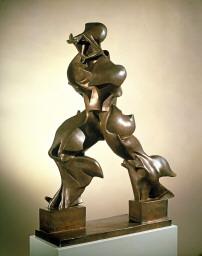London's tribute to Futurism, which celebrates its 100th birthday this year, kicks off with an exhibition devoted to the drawing and sculpture of Umberto Boccioni.
Boccioni (1882-1916) was one of the earliest and most vocal supporters of the movement, which was officially launched with the publication of a manifesto by Italian writer Filippo Tommaso Emilio Marinetti in 1909.
The document, which appeared in French daily Le Figaro on February 20, expressed the Futurists' key ideas: a love of technology, industry and speed, and a loathing of the past.
This was later embodied in Futurist artists' rampant colours and violent energy, extolling the merits of a new, technologically advanced age.
Boccioni, who is today considered one of Futurism's leading lights, explored its revolutionary ideas through both art and writing.
The centrepiece of the London exhibition is a renowned bronze sculpture by Boccioni, entitled Unique Forms of Continuity in Space (1913).
The flowing sculpture, which appears on the Italian 20-cent coin, was intended to express movement and fluidity and is today considered one of Futurism's greatest masterpieces.
On show at London's only gallery of 20th-century Italian art, the Estorick Collection, the exhibition is the first in Britain to focus entirely on Boccioni's work.
''We hope this event will give people a chance to get to know Boccioni better, both as an individual artist and in the context of the Futurist movement,'' said the Estorick's director, Roberta Cremoncini.
''Futurism is frequently associated with Fascism in the UK, and we are always having to explain that the first wave of Futurism - the one that Boccioni was involved in - developed between 1909 and 1916 when he died, and therefore had absolutely nothing to do with Fascism.
''As for the so-called second wave of Futurism, this was critically re-evaluated in Italy during the early 1970s and is now accepted and studied''.
Born in the southern region of Calabria, Boccioni was influenced by Divisionism and Impressionism during his early career.
He first met Marinetti in 1907 and after the publication of the Futurist manifesto, Boccioni played a crucial role in integrating visual arts into the literary movement, eventually becoming Futurism's leading theorist.
Originally a painter, he began experimenting with sculpture after seeing the works of Medardo Rosso in Paris and became a strong advocate of exploring different materials.
He was called to serve in World War I and died at the age of 34 during a training accident.
The exhibition runs at the Estorick Collection in north London until April 19.
In June, the Tate Modern will host its own tribute to Futurism, with a wide-ranging event featuring work by many different artists.









